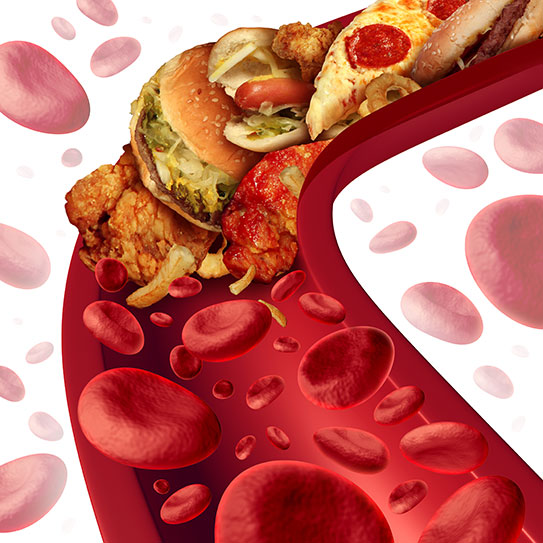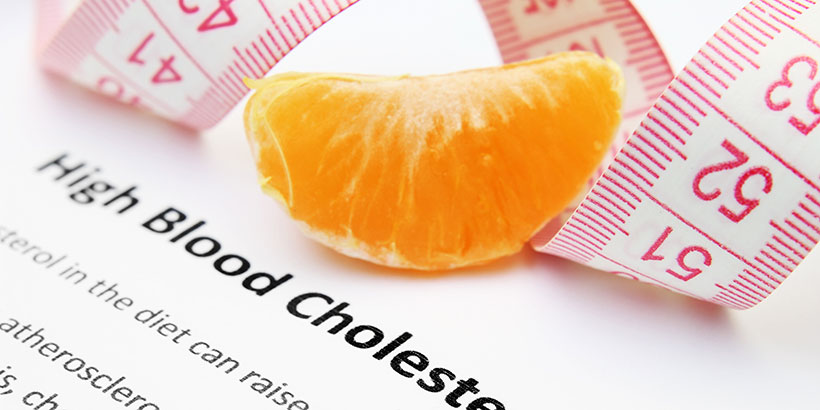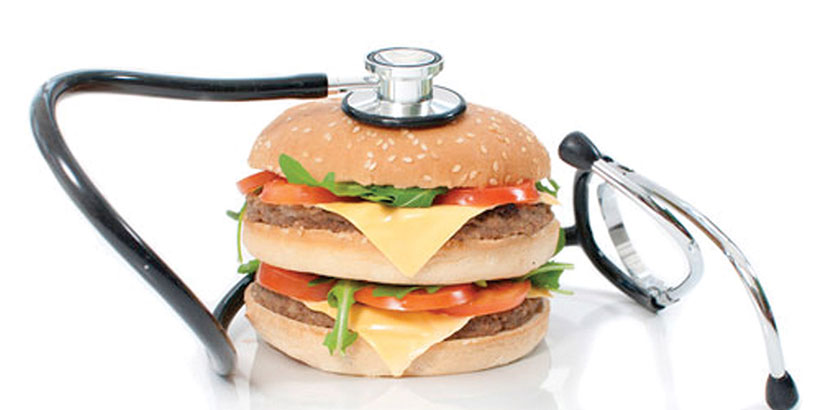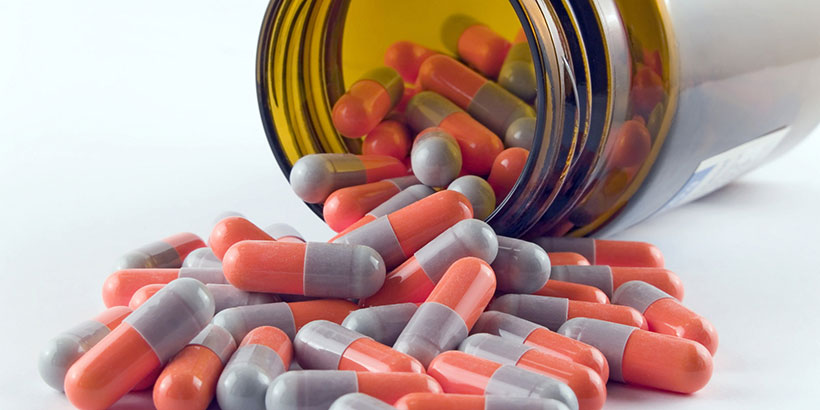
Холестерин доставляется в разные части организма в особых белковых капсулах. Есть два основных вида капсул, которые направляются в противоположные стороны. Вы наверняка слышали о них — когда проверяют холестерин в крови, говорят о ЛПВП и ЛПНП (липопротеиды высокой и, соответственно, низкой плотности). Их еще называют «хорошим» (ЛПВП) и «плохим» (ЛПНП) холестерином. Хороший полицейский, плохой полицейский. Как в кино. Но даже такая упрощенная картина все же ближе к истине.
Что происходит, когда мы едим много насыщенных жиров? Уровень «хорошего» холестерина повышается. Статистика доказывает, что высокий показатель «хорошего» холестерина — мощная защита против сердечно-сосудистых заболеваний. Одно это заставляет усомниться в том, что «жиры повышают холестерин и приводят к сердечно-сосудистым заболеваниям». Насыщенные жиры повышают уровень ЛПВП и дают более высокий показатель общего холестерина, поскольку ЛПВП — его составная часть. Но высокий уровень ЛПВП снижает риск сердечно-сосудистых заболеваний, а не наоборот. Высокий уровень «хорошего» холестерина защищает нас от болезней сердца.
Перейдем теперь к «плохому» холестерину, ЛПНП. Как часто бывает в кино, у злодея более интересная роль, и у «плохого» холестерина тоже есть свои положительные стороны. Кто знает, может, это просто обстоятельства или несчастливое детство стали виной тому, что он перешел на сторону зла? Может, наркотики? Потому что переизбыток сахара и крахмала со временем может превратить ЛПНП в настоящего злодея.
Что происходит, когда мы едим много насыщенных жиров? Уровень «хорошего» холестерина повышается. Статистика доказывает, что высокий показатель «хорошего» холестерина — мощная защита против сердечно-сосудистых заболеваний. Одно это заставляет усомниться в том, что «жиры повышают холестерин и приводят к сердечно-сосудистым заболеваниям». Насыщенные жиры повышают уровень ЛПВП и дают более высокий показатель общего холестерина, поскольку ЛПВП — его составная часть. Но высокий уровень ЛПВП снижает риск сердечно-сосудистых заболеваний, а не наоборот. Высокий уровень «хорошего» холестерина защищает нас от болезней сердца.
Перейдем теперь к «плохому» холестерину, ЛПНП. Как часто бывает в кино, у злодея более интересная роль, и у «плохого» холестерина тоже есть свои положительные стороны. Кто знает, может, это просто обстоятельства или несчастливое детство стали виной тому, что он перешел на сторону зла? Может, наркотики? Потому что переизбыток сахара и крахмала со временем может превратить ЛПНП в настоящего злодея.

У «хорошего» и «плохого» холестерина разные задачи. «Хороший» выводит из организма излишек холестерина, доставляя его в печень на утилизацию. То есть следит за чистотой.
Капсулы с ЛПНП выполняют обратную функцию — они переносят холестерин в ткани, снабжая организм холестерином. В печени образуются большие капсулы с ЛПНП, которые затем отправляются в кровь (в анализе крови на холестерин эти большие капсулы называются триглицеридами). Клетки организма призывают ЛПНП к себе и забирают содержимое капсул, из-за чего капсулы уменьшаются в размерах, а могут забирать и все капсулы целиком. У здоровых людей большие капсулы ЛПНП постепенно уменьшаются до средних размеров, а потом уже попадают в клетки. Пока еще все идет нормально, никакой беды в этом нет. ЛПНП поставляют в клетки жизненно необходимый холестерин — строительный материал.
С некоторыми западными болезнями дело обстоит сложнее. Клетки больных людей не хотят забирать себе капсулы ЛПНП целиком. Они забирают их лишь частично. Капсулы ЛПНП уменьшаются, и в крови скапливается множество мелких плотных ЛПНП. Прогоркая, они могут испортить внутренние стенки сосудов. Они оседают на них, напоминая пустые упаковки и прочий мусор на обочине. Возникает риск закупорки сосудов.
Эти ненужные маленькие плотные ЛПНП, похоже, и есть по-настоящему опасный, суперзлодейский холестерин. Не всякий холестерин опасен. И даже не всякие капсулы ЛПНП. Крупные, «пышные», нормальные капсулы ЛПНП представляются безобидными.
Жиры и насыщенные жирные кислоты, в частности, повышают уровень ЛПВП и ЛПНП среднего размера, то есть «хороший» холестерин.
Старые тесты тоже показывали эту зависимость, поэтому их считали опасными. Это и стало причиной катастрофической ошибки. Мелкие плотные ЛПНП, представляющие наибольшую опасность, старые тесты не обнаруживали. Наверняка вы уже догадались, отчего они появляются в крови.
Подсказка: не от жирной пищи.

Как заработать четырнадцать миллиардов долларов
Маргариновые деньги Becel — это цветочки. Больше всего прибыли холестерин принес фармацевтической промышленности.
Самое продаваемое лекарство — это липитор, выпускаемый компанией Pfizer-2. Этот снижающий холестерин препарат возглавляет топ-лист наиболее прибыльных лекарств — его продажи приносят около четырнадцати миллиардов долларов во всем мире. Ежегодно.
Липитор относится к классу так называемых статинов. В Швеции наиболее известен его аналог — симвастатин. Статины — эго величайшее достижение современной фармацевтики. Они снижают риск инфаркта миокарда и преждевременной смерти у пациентов, страдающих сердечно-сосудистыми заболеваниями.
Пока что придраться не к чему. Но коммерческие предприятия не хотят продавать лекарство только тем, кому оно действительно показано. Они хотят продавать его всем подряд.
Знакомые методы, правда? У большинства здоровых европейцев показатель холестерина выше 5 ммоль/л, особенно у людей старшего возраста. Каждый третий пожилой европеец ежедневно принимает препараты, снижающие холестерин. Огромные размеры прибыли в этой отрасли уже перестали кого-либо удивлять. Как сказал Олдос Хаксли, «Медицина сделала такой огромный скачок, что здоровых людей уже почти не осталось».
Как же работают эти статины, в которых сегодня якобы нуждаются все больше людей? Как они влияют на показатели холестерина и риск сердечно-сосудистых заболеваний? В действительности все проще, чем кажется. Статины — это противоядие.
Статины влияют на фермент ГМГ-КоА-редуктаза, или HMGR. Оба названия — аббревиатуры. Не будем мучить вас расшифровкой. Она в три раза длиннее и в десять раз непонятнее. Можно только посочувствовать студентам-медикам, которым приходится запоминать сотни подобных химических названий и реакций. Бывает только, что многие после этого за деревьями не видят леса.

Этот фермент можно назвать строителем холестерина. Он отвечает за образование холестерина в клетках организма и определяет его количество. Статины застревают в ГМГ-КоА-редуктазе и угнетают ее функцию, нарушая механизм, отвечающий за образование холестерина. Как будто в двигатель бросили пригоршню гравия. Внезапно клетки перестают справляться с собственным производством холестерина.
Если клетки не могут самостоятельно производить холестерин, они берут больше из крови, «высасывая» капсулы ЛПНП. Для тех, кто страдает метаболическим синдромом и у кого в крови много мелких плотных капсул ЛПНП, это неплохо. Ненужный побочный эффект заключается в том, что статины одновременно воздействуют на общий уровень холестерина в крови. Статины снижают риск инфаркта у пациентов, страдающих сердечно-сосудистыми заболеваниями, вероятно потому, что одновременно уничтожают мелкие опасные капсулы ЛПНП.
То есть необязательно вести здоровый образ жизни и есть здоровую пищу, достаточно раз в день пить статины, а заодно и другие таблетки против других факторов риска. Правда, неплохо?
То есть необязательно вести здоровый образ жизни и есть здоровую пищу, достаточно раз в день пить статины, а заодно и другие таблетки против других факторов риска. Правда, неплохо?


